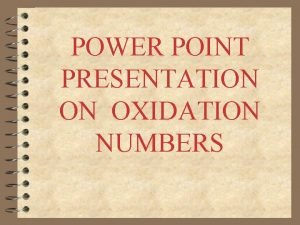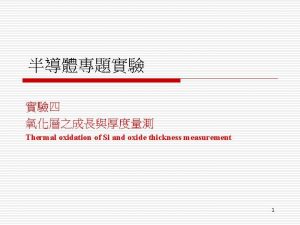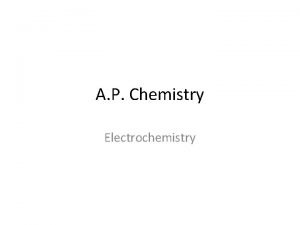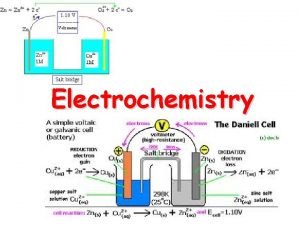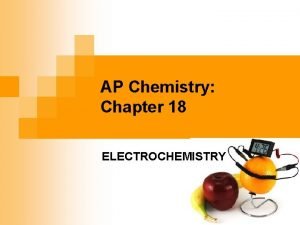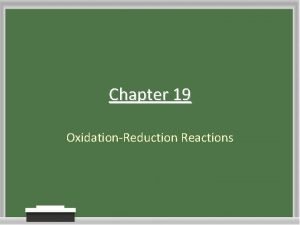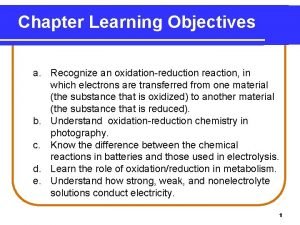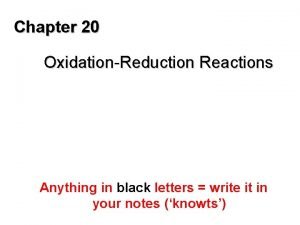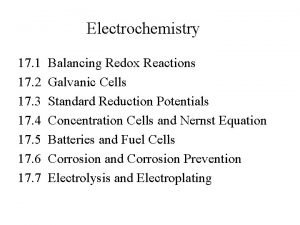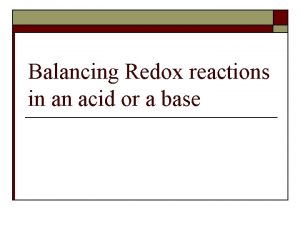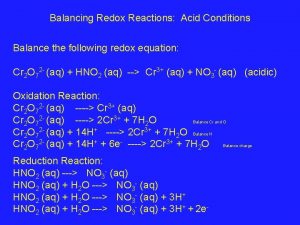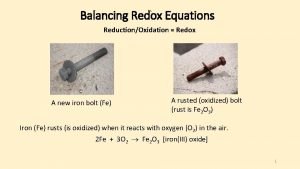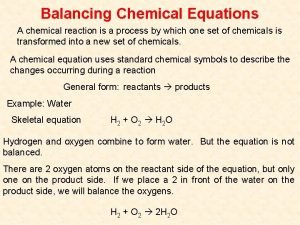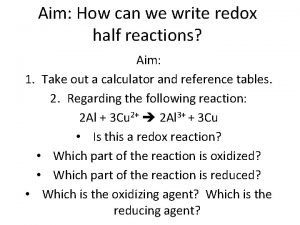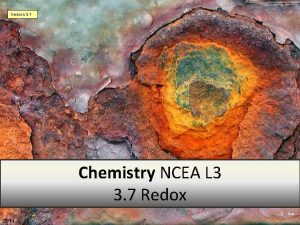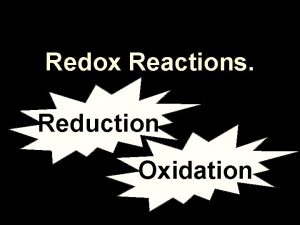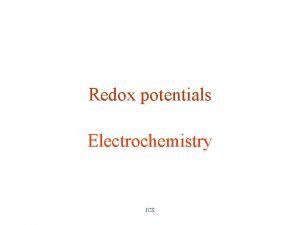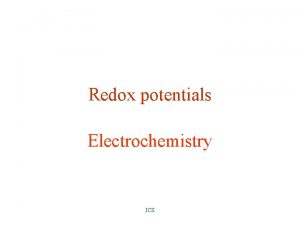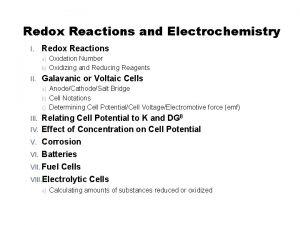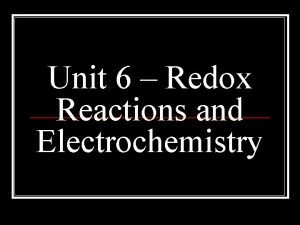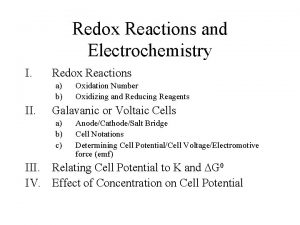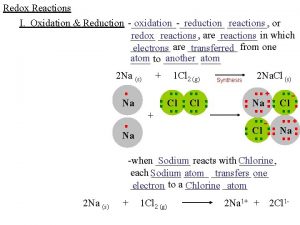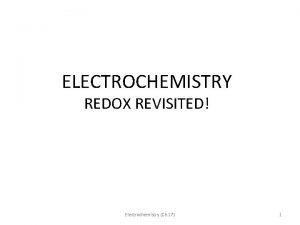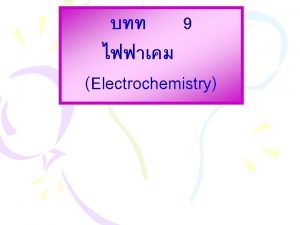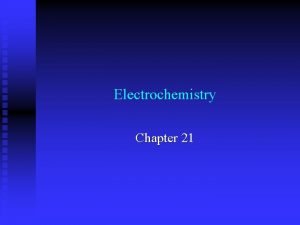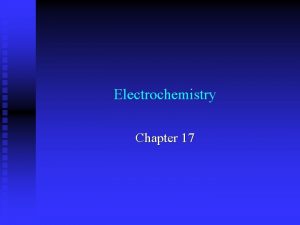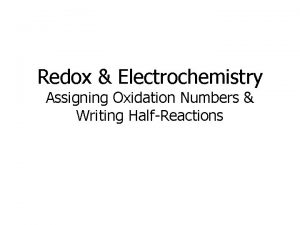Electrochemistry Chemistry 30 Redox Reactions Redox oxidation and
































- Slides: 32

Electrochemistry Chemistry 30

Redox Reactions • Redox = oxidation and reduction • Originally, oxidation meant combination with oxygen (corrosion, combustion), but now means loss of electrons • Reduction originally meant refining metal ores to pure metals, causing a reduction in mass, but now means gain of electrons • In general, redox reactions occur when there is a transfer of electrons

Example: Redox The single displacement reaction between copper and silver is: Cu (s) + 2 Ag. NO 3 (aq) → 2 Ag (s) + Cu(NO 3)2 (aq) a. Write the total and net ionic equations. b. Which metal is being oxidized? c. Which metal is being reduced?

Trick for Redox

Oxidation States/Numbers • Positive/negative number for an atom or ion that reflects partial gain or loss of electrons • Rules in reference book • One oxidation number for EACH atom/ion, so must pay attention to subscripts, but coefficients (for balancing equation) do not matter

Example: Oxidation States Determine the oxidation number for each element in the following compounds: a. S 8 b. H+ c. Sn. O 2 d. CO 32 e. Al 2(SO 4)3 f. Na 3 Co(NO 2)6

Identifying Redox Reactions • Oxidation numbers can be used to identify if a reaction is a redox reaction • If no elements change oxidation states between reactant and products, then no redox occurs

Example: Identifying Redox Use oxidation numbers to determine if these are redox reactions. a. 3 Hg 2+ (aq) + 2 Fe (s) → 3 Hg 2 (s) + 2 Fe 3+ (aq) b. Na. Cl (aq) + Ag. NO 3 (aq) → Ag. Cl (s) + Na. NO 3 c. 2 As (s) + 3 Cl 2 (g) → 2 As. Cl 3 (s)

Half-Reactions • Breaks a full reaction apart into reduction equation and oxidation equation • Example: Zn (s) + 2 HCl (aq) → Zn. Cl 2 (aq) + H 2 (g) becomes… Zn (s) → Zn 2+ (aq) + 2 e 2 H+ (aq) + 2 e- → H 2 (g) • Must be balanced by mass (atoms/ions) and charge

Example 1: Half-Reactions Zn (s) + Pb(NO 3)2 (aq) → Pb (s) + Zn(NO 3)2 (aq) a. Write net ionic equation. (What is the spectator ion? ) b. Write the half-reaction for zinc. c. Write the half-reaction for lead. d. Identify which element is being oxidized and which is being reduced.

Example 2: Half-Reactions Write both half-reactions, and identify which element is being oxidized and which is being reduced. Sn. O 2 (s) + C (s) → Sn (s) + CO 2 (g)

Acidic Conditions • Means there is excess H+ ions in the solution To write: • Create the half-reactions as usual • Balance elements other than H and O • Add H 2 O to balance out oxygen atoms (to the opposite side of the arrow) • Add H+ to balance out hydrogen in the water molecules • Add charges and put electrons on the proper side

Example: Acidic Conditions Write the half-reaction for dichromate, Cr 2 O 72 -, forming chromium(III) ions in acidic solution.

Basic Conditions • Means there is an excess of hydroxide ions • As with other base calculations, more steps here To write: • Steps are the same as for acidic conditions, with one additional step: Add OH- ions to both sides to balance all H+ • Cannot end up with H+ in your end reaction (bases have OH-, not H+)

Example: Basic Conditions Write the half-reaction for solid silver forming silver oxide in basic solution.

Balancing with Half-Reactions • Break reaction into two half-reactions; remove spectator ions • Balance each half-reaction separately, by mass and charge • Compare both half-reactions so total number of e - is equal for both (multiply each half-reaction by whole number) • Add half-reactions together and add back spectator ions

Example 1: Balancing with HR Mg (s) + Cl 2 (g) → Mg. Cl 2 (s)

Example 2: Balancing with HR Cu (s) + Ag. NO 3 (aq) → Cu(NO 3)2 (aq) + Ag (s)

Example 3: Balancing with HR Mn. O 4 - + Fe 2+ + H+ → Mn 2+ + Fe 3+ + H 2 O

Acidic Solutions • Create half-reactions as usual, using steps for half -reactions in acidic conditions • Balance electrons in both half-reactions, then add together • Cancel common terms

Example: Acidic Solutions Balance the following reaction in acidic conditions: Cr 2 O 72 - (aq) + HNO 2 (aq) → Cr 3+ (aq) + NO 3 - (aq)

Basic Solutions • Create half-reactions as usual, using steps for half -reactions in basic conditions • Balance electrons in both half-reactions, then add together • OH- and H+ ions (on the same side) combine to form water • Cancel common terms

Example: Basic Solutions Balance the following reaction in basic conditions: Cu (s) + HNO 3 (aq) → Cu 2+ (aq) + NO (g)

Voltaic Cells • AKA galvanic cells • Half-reactions are split into two separate cells, connected by a conducting material and a salt bridge.

Cell Notation anode | electrolyte | cathode • Anode is the site of oxidation (An Ox) • Cathode is the site of reduction (Red Cat)

Standard Reduction Potential • Indicates the tendency of an element to gain electrons • In electrochemical cells, identifies which element will be oxidized and which will be reduced • Measured in volts, relative to reduction potential of hydrogen (0. 0 V), at standard conditions (25°C, 1 atm, 1 mol/L solutions)

Standard Reduction Potential • The half-cell higher up the list (more positive) will be reduced; other will be oxidized

Example: Voltaic Cells For the two half-reactions: Zn (s) → Zn 2+ (aq) + 2 e. Ag (s) → Ag+ (aq) + ea. Write the half-reactions in cell notation. b. Draw a diagram of the electrochemical cell, assuming is it spontaneous. Label the electrodes, electrolytes, direction of electron flow and direction of ion movement. c. What would be a suitable substance for the salt bridge for this reaction?

Cell Potential •

Example 1: Cell Potential Determine the cell potential for the overall cell reaction: 2 Al 3+ (aq) + 3 Cu (s) → 3 Cu 2+ (aq) + 2 Al (s)

Example 2: Cell Potential Determine the cell potential for the overall cell reaction: Cd (s) + 2 NO 3 - (aq) + 4 H+ (aq) → Cd 2+ (aq) + 2 NO 2 (g) + 2 H 2 O (l)

Example 3: Cell Potential An electrochemical cell is constructed with iron (making Fe 3+ ions) and calcium. a. Determine the anode and cathode, if the cell is spontaneous. b. Write the cell notation. c. Calculate the standard cell potential.
 Redox examples
Redox examples Chemistry unit 5 reactions balancing reactions worksheet
Chemistry unit 5 reactions balancing reactions worksheet Oxidation
Oxidation Oxide thickness color chart
Oxide thickness color chart Ap chemistry chapter 18 electrochemistry test
Ap chemistry chapter 18 electrochemistry test Ap chemistry electrochemistry
Ap chemistry electrochemistry What is electrochemistry in chemistry
What is electrochemistry in chemistry What is electrochemistry in chemistry
What is electrochemistry in chemistry Electrochemistry ap chemistry
Electrochemistry ap chemistry Chapter 19 review oxidation-reduction reactions
Chapter 19 review oxidation-reduction reactions Reducing agent strength table
Reducing agent strength table Balancing oxidation reduction reactions
Balancing oxidation reduction reactions Redox reduction
Redox reduction How to write reduction half reactions
How to write reduction half reactions Oxidation–reduction reactions
Oxidation–reduction reactions Leo the lion says ger
Leo the lion says ger Oxidation reduction reactions
Oxidation reduction reactions Types of chemical reactions redox
Types of chemical reactions redox Oilrig oxidation
Oilrig oxidation Balancing redox reactions in basic solution
Balancing redox reactions in basic solution Electrode concentration cell
Electrode concentration cell Redox reaction example
Redox reaction example Leo and ger
Leo and ger Balance redox reactions
Balance redox reactions Balancing redox reactions in acid
Balancing redox reactions in acid Balance redox reactions
Balance redox reactions Activity series oxidation
Activity series oxidation Rules for balancing redox reactions
Rules for balancing redox reactions Balancing redox reactions calculator
Balancing redox reactions calculator Redox reactions ncea level 2
Redox reactions ncea level 2 Half equation worksheet
Half equation worksheet How redox reactions work
How redox reactions work Concept map of oxidative phosphorylation
Concept map of oxidative phosphorylation


